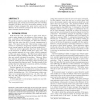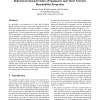CEAS
2011
Springer
13 years 3 months ago
2011
Springer
Traditional content-based e-mail spam filtering takes into account content of e-mail messages and apply machine learning techniques to infer patterns that discriminate spams from...
BIOSYSTEMS
2008
14 years 3 months ago
2008
In this paper, an immune-inspired model, named IA-AIS (Innate and Adaptive Artificial Immune System) is proposed and applied to the problem of identification of unsolicited bulk e...
USENIX
2003
14 years 4 months ago
2003
We present Active Spam Killer (ASK), a program that attempts to validate unknown senders before allowing delivery of their message. Validation occurs by means of a challenge reply...
CEAS
2008
Springer
14 years 5 months ago
2008
Springer
This paper presents a methodology for the characterization of spamming strategies based on the identification of spam campaigns. To deeply understand how spammers abuse network re...
CEAS
2006
Springer
14 years 6 months ago
2006
Springer
We provide a model to study the effects of three methods of fighting spam mail, namely (1) increasing the cost of mailing messages, (2) filters, and (3) a do-not-spam registry, on...
CEAS
2005
Springer
14 years 8 months ago
2005
Springer
Spam has become a serious problem of Internet, and the current defense is limited to the filters deployed at the recipient side. Little known research has been applied to reduce ...
ICC
2007
IEEE
14 years 9 months ago
2007
IEEE
By analyzing a two-month trace of more than 25 million emails received at a large US university campus network, of which more than 18 million are spam messages, we characterize th...


